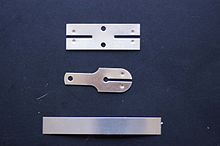Battery pack
An interconnected package of several accumulator cells is referred to as a battery pack , which is held together for practical use by an envelope or a housing and is often also protected from external influences. Battery packs are designed to be removable or replaceable and have detachable electrical contacts , often through connectors .
The cells used should all belong to the same type from one manufacturer, i.e. have the same voltage, capacity and load capacity as possible. Blocks of several cells can also be connected in parallel within a battery pack, and several such cell blocks in turn in series.
Voltage of a battery pack
The nominal voltage of the battery pack results from the sum of the nominal voltages of the cells or cell blocks connected in series . It is based on the manufacturer's standard specifications and helps determine the design of the charger .
The actual voltage of a battery pack differs depending on the state of charge. The highest value is determined by the charge voltage of the used charging method is determined. The lowest voltage is the final discharge voltage specified by the manufacturer , at which a harmful deep discharge of individual cells is to be prevented.
Capacity of a battery pack
The nominal capacity is given in ampere-hours (Ah). With simple series connections, the nominal capacity of the battery pack corresponds to that of a single cell. If there are cell blocks consisting of cells connected in parallel, it results from the sum of the nominal capacities of the individual cells connected in parallel.
With series connections, however, the usable capacity is determined by the weakest link in the chain. It therefore corresponds to the cell or cell block with the lowest capacity.
Energy content of the battery pack
Although all cells of a battery pack should be of the same type and, if possible, the same production batch, the actual values of the cells always differ in practice. The causes are manufacturing tolerances and / or uneven aging of the individual cells. The nominal energy content is the sum of the individual energy contents of the individual cells or cell blocks.
The usable energy content of a battery pack results from the cell or cell block of cells connected in parallel with the lowest capacity multiplied by the number of cells or cell blocks connected in series. It is specified in watt hours (Wh) or kilowatt hours (kWh). When new, it can be higher than the nominal energy content (overcapacity of the cells), but decreases with use, aging and degradation .
Designation system for the cell configuration

A system of abbreviations has been established for the structure of battery packs. It provides information on how many cells are connected in parallel and in series within a pack.
A 3S2P battery pack, for example, contains a total of 6 cells. Thereof each 2 cells are p arallel (2P) installed. Three of these cell pairs are s connected eriell (3S), ie in series. In the case of simple series connections, only one number and one letter are sometimes used. 4S denotes a battery pack with 4 cells connected in series. This form of designation is often found on balancer connections .
Use of battery packs
Battery packs are particularly common in industrial products, e.g. B. network-independent credit card readers and cordless landline telephones, also as traction batteries for driving smaller vehicles or in model making for the functionality of the models. Today's packs usually consist of NiMH cells or lithium batteries . NiCd cells are no longer installed in current devices due to their environmental impact during disposal.
Assembly of the cells
In a battery assembly, individual cells are assembled into a package. The packages consist of several cells, depending on the desired voltage and energy content. The cells can be built up mechanically in any arrangement: in a row, in column form or in a circle. In industrial mass production, this is usually done automatically. There are numerous variants of battery packs, e.g. B. with PTC resistor (a temperature-dependent resistor that reduces the charging current if the cells get too hot), balancer connections for cell maintenance or integrated balancer circuits.
Shrink tubing , half-shells over the cell connectors or solid housings are often used for the covering . The cell connectors and terminal lugs are made from simple strips or with punched-in points (so-called H connectors). Battery packs made from cells with screw connections are also manufactured. With them, individual cells can be exchanged.
NiCd battery pack with half shells
Battery pack with charge level indicator in a solid housing for a Pedelec





